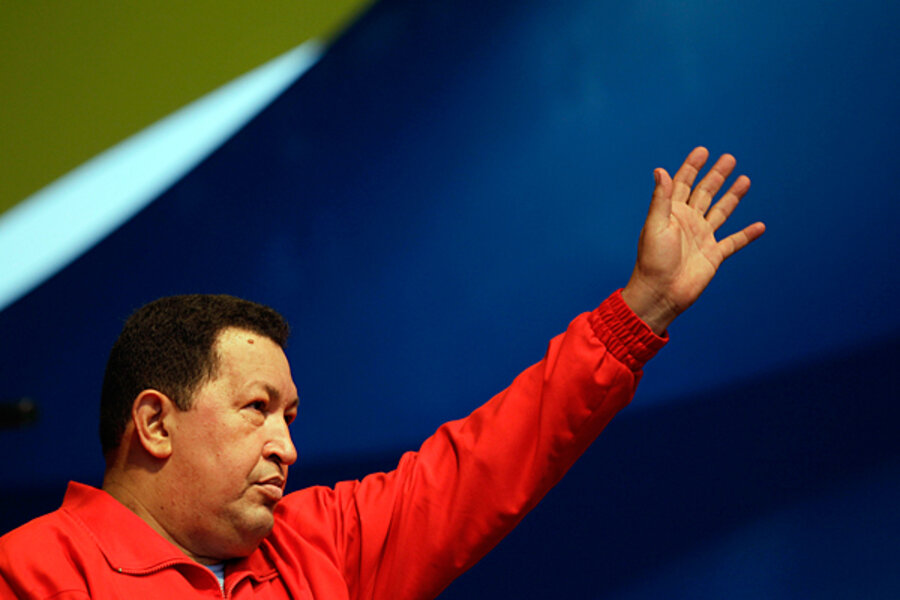Venezeula: Leftist collectives keep the peace, but raise fears during election year
Loading...
• Insight Crime researches, analyzes, and investigates organized crime in the Americas. Find all of Elyssa Pachico’s work here.
In a particularly tense election year for Venezuela, there are new fears that the militant collectives in Caracas' 23 de Enero barrio are stirring trouble, with no sign the groups will disappear so long as they are the only competent force providing the neighborhood with security.
The barrio of 23 de Enero in Caracas is a bastion of support for President Hugo Chavez, with even a few giant man-shaped Chavez balloons billowing off the rooftops of several buildings to prove it. The leftist barrio is famous for its militancy, including its plaza dedicated to the leaders of Colombian guerrilla group the Revolutionary Armed Forces of Colombia (FARC), which features a statue of independence hero Simon Bolivar as a machete-wielding peasant.
23 de Enero is a stronghold for radical self-defense collectives, who train their recruits in Marxist-Leninist ideology and who are known to patrol the neighborhood late at night toting walkie-talkies and wearing dark bandannas across their faces. One of the largest of these collectives, La Piedrita, gained notoriety earlier this year after several children posing with (allegedly plastic) M-16 rifles were photographed in front of a neighborhood mural depicting Jesus and the Virgin Mary carrying guns. The images caused an outcry, and since then Jesus’ assault weapon has been painted over with a large blue book that represents the constitution.
There are thought to be some eight collectives in 23 de Enero, amounting to 2,000 armed volunteers, according to a 2011 International Crisis Group report. Images such as the gun-toting children have arguably bolstered fears that the groups’ radical ideology has taken a new, aggressive turn during this election year. Such concerns were reinforced when the opposition’s presidential candidate, Henrique Capriles, tried to campaign in an adjacent, pro-Chavez neighborhood in March, and a gunfight broke out. The opposition blamed the incident on the local collectives. 23 de Enero residents have also reportedly warned the Capriles campaign against entering the neighborhood, the Crisis Group report stated.
RELATED: How much do you know about Venezuela's Hugo Chavez?
Also contributing to the sense that the collectives have become particularly combative this year are various media reports that the groups are behind several outbreaks of violence. In March, the murder of two young men in one section of 23 de Enero reportedly provoked La Piedrita to storm a neighborhood, setting vehicles on fire and firing gunshots. The group later strongly criticized media reports that described the confrontation as a “war” between neighborhood collectives. According to El Universal, La Piedrita blamed the murders on “narco-paramilitaries” who ambushed the two victims. More recently, unnamed local residents claimed the conflict broke out because La Piedrita is trying to assert its control over a rival collective’s territory, El Universal reported.
Conflict between the 23 de Enero collectives is not unheard of. La Piedrita and another prominent group, the Tupamaros, have previously seen brief bursts of open street warfare between 2005 and 2007. But as New York University (NYU) professor Alejandro Velasco points out, much of the conflict between the collectives is because of their ideological differences, not over territory.
“The tensions between the [collectives] are very real, and very lethal,” Mr. Velasco told InSight Crime in an e-mail. Some of the collectives have shunned others for seeking partisan ties with the ruling party, the PSUV, a decision viewed by some as “selling out,” Velasco said.
But while it is unclear whether La Piedrita is again butting heads with another local collective, their assertion that “narco-paramilitaries” were somehow involved with the March killings draws attention to the collective’s fundamental reason for existence. Groups like La Piedrita formed primarily in order to defend residents against state-sponsored violence and local criminals. By citing the threat of outsiders deemed “narco-paramilitaries,” La Piedrita seemed to invoke its original status as a self-defense group.
“There is a void of official, state authority in 23 de Enero that has helped justify the formation of these groups,” said Pedro Rangel, director of a Caracas-based think tank, Incosec, that studies conflict dynamics in the capital. “But legally speaking, that authority to provide security should only be in the hands of the police.”
Currently, the police are nowhere to be seen in 23 de Enero. One police control station is an empty cement building. Another one has been transformed into the colorful headquarters for another collective, the Coordinadora Simon Bolivar. The police were essentially kicked out of the neighborhood in 2005, and are viewed as brutal, corrupt and inefficient.
In the meantime, the collectives essentially act as local vigilantes. Drug dealing and petty theft are acknowledged problems in 23 de Enero, and the groups are known to take action against offenders if they receive complaints from residents. Night patrols are common, and collective members openly carry weapons.
“There is no due process here,” NYU professor Velasco said. “It’s trial by execution.”
The collectives’ role as the local law enforcers has also fed the fears that, should Chavez face an unfavorable outcome in the October 7 elections, these local groups are far too powerful and entrenched to accept a transition in government. But if an opposition government decides to challenge the role of the collectives in 23 de Enero -- one that should be filled by a competent city police force -- by complaining that they exist because they are “propped up by Chavez” would be ignoring reality. It may well be easier to remove weapons from the city’s murals than from the hands of La Piedrita.
– Insight Crime researches, analyzes, and investigates organized crime in the Americas. Find all of Elyssa Pachico’s work here.







